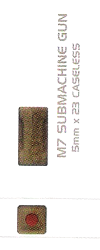M443 Caseless Full Metal Jacket: Difference between revisions
From Halopedia, the Halo wiki
(→Overview: Typo) Tag: Mobile edit |
m (Grammar correction. As Spartan is singular, the correct possessive is "his or her") |
||
| Line 8: | Line 8: | ||
This feature is very beneficial. It reduces friction inside the magazine, one of the main causes of jamming in weapons. It also negates the need to expel brass casings, which also is a major cause of jamming, as mentioned above. | This feature is very beneficial. It reduces friction inside the magazine, one of the main causes of jamming in weapons. It also negates the need to expel brass casings, which also is a major cause of jamming, as mentioned above. | ||
By a stroke of luck, this is important to a user wielding two M7s at once, such as a [[Spartan]], who would not want to have hot brass flying in his or her face from the eject port of the weapon in | By a stroke of luck, this is important to a user wielding two M7s at once, such as a [[Spartan]], who would not want to have hot brass flying in his or her face from the eject port of the weapon in his or her left hand. The projectile itself is "jacketed," or coated, in metal (possibly copper or steel) to aid in penetration of the target. "Caseless" rounds are actually embedded into the block of propellant, reducing their length, allowing more ammo to be stored in a smaller space. | ||
==Trivia== | ==Trivia== | ||
Revision as of 14:09, October 5, 2019

The M443 Caseless Full Metal Jacket (M443 Caseless FMJ) is a type of 5×23mm projectile ammunition used in the M7 Caseless Submachine Gun and its suppressed variant.[1][2]
Overview
This ammunition is classified as "caseless", meaning it does not have a metallic casing surround the powder and sealing the bullet, propellant, and primer together. Instead of using this casing, the round uses a combustible adhesive to seal these components together. Because the chemical "casing" is vaporized when fired, there is no need to eject spent brass shell casings.
This feature is very beneficial. It reduces friction inside the magazine, one of the main causes of jamming in weapons. It also negates the need to expel brass casings, which also is a major cause of jamming, as mentioned above.
By a stroke of luck, this is important to a user wielding two M7s at once, such as a Spartan, who would not want to have hot brass flying in his or her face from the eject port of the weapon in his or her left hand. The projectile itself is "jacketed," or coated, in metal (possibly copper or steel) to aid in penetration of the target. "Caseless" rounds are actually embedded into the block of propellant, reducing their length, allowing more ammo to be stored in a smaller space.
Trivia
Real caseless weapons suffer from problems with "cooking off", which is when incredible temperatures result in a cartridge firing unintentionally. Since there is nothing insulating the combustible material from the heat (one of the uses of a brass casing), even regular temperatures in the firing could result in the cartridge going off, leading to damage to the weapon, possibly even the user, or even the weapon accidentally firing. The main way to prevent cooking-off in caseless weapons is by, electronic firing, but this system requires a battery, which may not be in constant supply in the battlefield. However, it could simply use a High Ignition Temperature Propellant similar to the 1980s prototype G11 assault rifle.
Gallery
List of appearances
- Halo: First Strike (First appearance)
- Halo 2
- Halo: The Graphic Novel
- Halo: Ghosts of Onyx
- Halo: Uprising
- Halo 3
- Halo: Contact Harvest
- Halo: The Cole Protocol
- Halo Wars
- Halo: Helljumper
- The Life
- Halo 3: ODST
- Halo Legends
- Halo: Evolutions - Essential Tales of the Halo Universe
- Halo: Blood Line
- Halo: Spartan Assault
- Halo 2: Anniversary
Sources
| |||||||||||||||||
